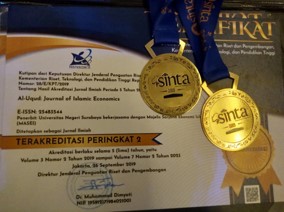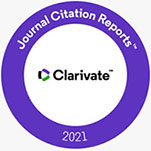What Attracts Guest to Stay? Brand Identity, Religiosity, and Reference Group towards Decision to Choose Sharia Hotel
DOI:
https://doi.org/10.26740/al-uqud.v4n1.p32-47Keywords:
Brand identity, Religiosity, Reference group, Decision to stay, Sharia hotelAbstract
Indonesia has one of largest Muslim population in the world. Therefore, currently it is not surprising that Sharia Branding is currently widely used by business entities ranging from banking to the hospitality business. This phenomenon is observed in the city of Surabaya in which Sharia hotels are mostly found such as the Namira Syariah Hotel. Nevertheless, the growth in the number of consumers who stay in Syariah hotels is not as much as conventional hotels. Therefore, the purpose of this research is to (1) to analyze the effect brand identity on the decision of consumers to stay at the Hotel Namira Syariah Surabaya, (2) to analyze the effect the consumer religiosity on consumers decision to stay at the Hotel Namira Syariah Surabaya, (3) to analyze the effect of the reference group to the decision to stay at the Hotel Namira Syariah Surabaya. This type of research uses a causal research approach. The population in this research is infinite but have ever stayed at the Hotel Namira Syariah Surabaya only but to all Muslim who at least 17 years old. The sample collection technique used is non-probability sampling with the number of samples is 210 respondents. The research instrument used a questionnaire, while data analysis used multiple linear regression analysis. From the results of the discussion and analysis of the data, it can be concluded that there is a positive influence of brand identity, religiosity and reference groups on the decision to stay at the sharia hotel.
References
Ananggadipa, A., Maulina, A. R. & Agustianingsih, E. (2013). Analisis Faktor-Faktor yang Mempengaruhi Nasabah (Mahasiswa) dalam Memilih Menabung pada Bank Syariah. Jurnal Elektronik, Universitas Gunadarma, Vol.5. https://ejournal.gunadarma.ac.id/index.php/pesat/article/view/1179/1040
Aoun, I., & Tournois, L. (2015). Building holistic brands: An exploratory study of halal cosmetics. Journal of Islamic Marketing. https://doi.org/10.1108/JIMA-05-2014-0035
Balmer, J. M. T. (2017). Advances in corporate brand, corporate heritage, corporate identity and corporate marketing scholarship. European Journal of Marketing. https://doi.org/10.1108/EJM-07-2017-0447
BPS Provinsi Jawa Timur. (2016). Statistik Hotel dan Akomodasi Lainnya di Indonesia. https://www.bps.go.id/publication/2016/12/09/e843e81d69d49fdc5f79ebd4/statistik-hotel-dan-akomodasi-lainnya-di-indonesia-2016.html
Butt, M. M., Rose, S., Wilkins, S., & Ul Haq, J. (2017). MNCs and religious influences in global markets: Drivers of consumer-based halal brand equity. International Marketing Review. https://doi.org/10.1108/IMR-12-2015-0277
Coleman, D. A., de Chernatony, L., & Christodoulides, G. (2015). B2B service brand identity and brand performance: An empirical investigation in the UKs B2B IT services sector. European Journal of Marketing. https://doi.org/10.1108/EJM-03-2013-0154
Delener, Nejdet. (1990). The Effects of Religious Factors on Perceived Risk in Durable Goods Purchase Decision. Journal of Consumer Marketing, Vol. 7 (3), pp. 27-38. https://doi.org/10.1108/EUM0000000002580
Dibb, Sally & Essoo, Nittin. (2004). Religious Influences on Shopping Behavior: An Exploratory Study. Journal of Marketing Management, Vol. 20 (7-8), pp. 683-712. https://doi.org/10.1362/0267257041838728
Ghofur, A., Susilo, S., Soedarto, J. P. H., Tembalang, S. H., & Tembalang, K. S. (2017). Maslaha as the philosophical, political and legal basis on the Islamic banking legislation in Indonesia. Global Journal Al Thaqafah, 7(1), 7-17. http://site.gjat.my/main/3074/index.asp?pageid=183818&t=volume-7-issue-1-
Glock Charles Y, Stark Rodney. Religion and Society in Tension. Chicago: Rand McNally; 1965.
Hartatin, Diana & Simajuntak, Megawati. (2016). The Effect of Value and Reference Group on Young Consumers Hedonic Buying. Journal of Consumer Sciences, Vol.1 (1), pp. 33-36. https://doi.org/10.29244/jcs.1.1.33-46
Hati, S. R. H., & Idris, A. (2019). The role of leader vs organisational credibility in Islamic social enterprise marketing communication. Journal of Islamic Marketing. https://doi.org/10.1108/JIMA-02-2017-0018
Hammerl, M., Dorner, F., Foscht, T., & Brandstätter, M. (2016). Attribution of symbolic brand meaning: the interplay of consumers, brands and reference groups. Journal of Consumer Marketing. https://doi.org/10.1108/JCM-12-2014-1243
Jalasena, Bintang Anoraga. (2013). Pengaruh Gaya Hidup dan Kelompok Acuan Terhadap Keputusan Pembelian Smartphone Merek Samsung Galaxy. Jurnal Ilmu Manajemen, Volume 1 Nomor 4 Juli 2013. https://journal.unesa.ac.id/index.php/bisma/article/view/2774
Johnson, B. R., Joon Jang, S. & Larson, D. B. (2001). Does Adolescent Religious Commitment Matter? A Reexamination of the Effects of Religiosity on Delinquency. Journal of Research in Crime and Delinquency. Vol. 38 (1), pp. 22-44. https://doi.org/10.1177%2F0022427801038001002.
Kotler, Philip and Kevin Lane Keller. 2012. Marketing Management, Edisi 14 New Jarsey: Prentice Hall Published.
Kushwah, S., Shree, D., Rezaei, S., & Sagar, M. (2019). The impact of culture on consumers perception of brand identity: Evidences from Gulf countries. Journal of Islamic Marketing. https://doi.org/10.1108/JIMA-12-2017-0146.
Lourenção, M. T. de A., & Giraldi, J. de M. E. (2017). Development of an identity model for sector brands. Journal of Fashion Marketing and Management. https://doi.org/10.1108/JFMM-10-2016-0097.
Lin, L., & Chen, Y. (2009). A study on the influence of purchase intentions on repurchase decisions: the moderating effects of reference groups and perceived risks. Tourism Review. https://doi.org/10.1108/16605370910988818.
Maholtra, N., Hall, John, Shaw, M. and Oppenheim, P. (2006). Marketing Research: An Applied Orientation, 3rd ed., pearson Education Australia, Frenchs, M.S.W
Maulan, S., Omar, N. A., & Ahmad, M. (2016). Measuring halal brand association (HalBA) for Islamic banks. Journal of Islamic Marketing. https://doi.org/10.1108/JIMA-09-2014-0058
Mindrut, S., Manolica, A., & Roman, C. T. (2015). Building Brands Identity. Procedia Economics and Finance. https://doi.org/10.1016/s2212-5671(15)00088-x
Mohd Yusof, Y. L., & Wan Jusoh, W. J. (2014). Islamic Branding: The Understanding and Perception. Procedia - Social and Behavioral Sciences, 130, 179185. https://doi.org/10.1016/j.sbspro.2014.04.022
Muhonen, T., Hirvonen, S., & Laukkanen, T. (2017). SME brand identity: its components, and performance effects. Journal of Product and Brand Management. https://doi.org/10.1108/JPBM-01-2016-1083
Nasrullah, R. (2015). Media Soial Prosedur, Tren, dan Etika, Bandung: PT Remaja Rosdakarya, 2015, pp. 15-47.
Raman, K., & Naik, P. A. (2004). Long-term profit impact of integrated marketing communications program. Review of Marketing Science, 2(1), 8. https://doi.org/10.2202/1546-5616.1014
Robinson, T., & Doss, F. (2011). Pre-purchase alternative evaluation: Prestige and imitation fashion products. Journal of Fashion Marketing and Management: An International Journal. https://doi.org/10.1108/13612021111151897
Roma, J. & Kartika, D. (2009). Brand Identity dan Perilaku Pembelian Produk Blackberry. Jurnal Riset Bisnis & Manajemen. 2. 24-33. http://dx.doi.org/10.23969/jrbm.v12i2
Roy, D., & Banerjee, S. (2008). Care-ing strategy for integration of brand identity with brand image. International Journal of Commerce and Management. https://doi.org/10.1108/10569210710776512.
Syed Shah Alam, S. S. A., Mohd, R., & Hisham, B. (2011). Is religiosity an important determinant on Muslim consumer behaviour in Malaysia? Journal of Islamic Marketing, 2(1), 83-96. https://doi.org/10.1108/17590831111115268
Tournois, L., & Aoun, I. (2012). From traditional to Islamic marketing strategies: Conceptual issues and implications for an exploratory study in Lebanon. In Education, Business and Society: Contemporary Middle Eastern Issues. https://doi.org/10.1108/17537981211251179
Utami, P. J. (2015). Hubungan Religiusitas dengan Perilaku Seksual pada Remaja di SMA Negeri 1 Banguntapan Bantul Yogyakarta. Naskah Publikasi. http://digilib.unisayogya.ac.id/122/1/NASKAH%20PUBLIKASI.pdf
Viot, C. (2011). Can brand identity predict brand extensions success or failure? Journal of Product and Brand Management. https://doi.org/10.1108/10610421111134941
Wardhani, W., Sumarwan, U., & Yuliati, L. N. (2015). Pengaruh persepsi dan preferensi konsumen terhadap keputusan pembelian hunian Green Product. Jurnal manajemen dan organisasi, 6(1), 45-63. https://doi.org/10.29244/jmo.v6i1.12183
Wilson, J. A. J., Belk, R. W., Bamossy, G. J., Sandikci, Ö., Kartajaya, H., Sobh, R., Liu, J., & Scott, L. (2013). Crescent marketing, Muslim geographies and brand Islam: Reflections from the JIMA Senior Advisory Board. In Journal of Islamic Marketing. https://doi.org/10.1108/17590831311306336.
Downloads
Published
How to Cite
Issue
Section
License
CC BY 4.0 Abstract views: 1100
,
Abstract views: 1100
, PDF Downloads: 845
PDF Downloads: 845








